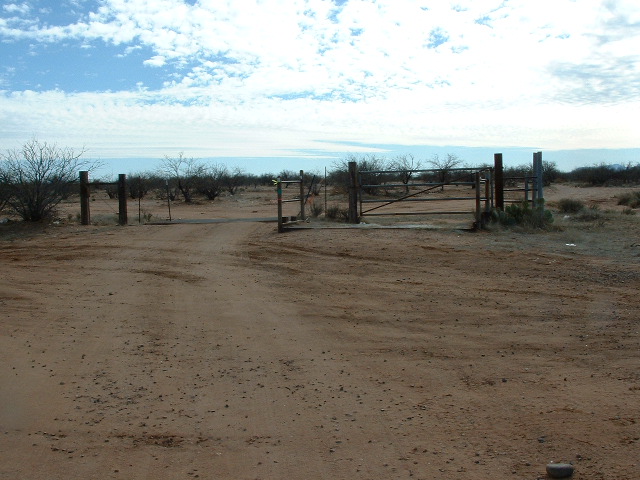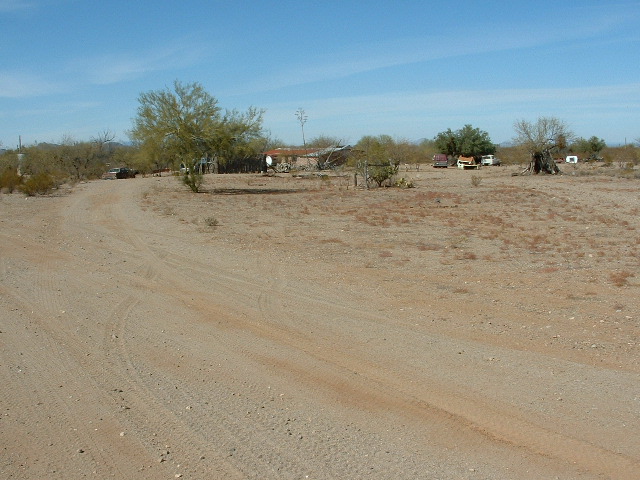In south central Arizona lies the Tohono O’odham Indian Reservation, a magical land the size of the state of Connecticut. To me, magical means “filled with 400 of the most beautiful desert peaks you’ll ever see”. The fact that it shares a 62-mile border with Mexico makes things even more interesting. I’d like to tell you about three places where you can drive across into Mexico, but I have to admit that doing that might not exactly be legal.
THE GATE
The USGS topographic map shows something at the border called “The Gate”, 30 miles south of the town of Sells. I had always wondered what the heck that was, so one day when I was climbing in the area, I drove the 200 yards of good dirt road from the highway and came up to the obvious fence at the international border. Sitting there, parked under a tree, was a Border Patrol jeep. I parked and approached it on foot.
A young Border Patrol officer came out of the jeep. I introduced myself, told him that I was climbing nearby, and we proceeded to talk for 45 minutes. He was most pleasant, and answered every question I had. Here are some of the things he told me.
The Border Patrol has a man stationed there all day, every day. In the morning, members of the Tohono O’odham who live in Mexico will drive up to The Gate and drop their kids off on the Mexican side. The kids then simply walk across the border into the U.S. and a school bus picks them up and takes them to Tohono O’odham schools in Topawa and Sells for the day. At the end of the day, the school bus drops the kids off again at The Gate and they walk across the border to where their waiting Mexican families take them home. The Gate is never locked – it is just a cattleguard.

The Gate
Mexican members of the tribe have ID cards, issued by the Tohono O’odham nation, which the Border Patrol recognizes and honors. They are allowed to enter the U.S. to shop and obtain free medical services and use the schools. Also, U.S. members of the tribe freely go into Mexico to buy beer and tequila and bring it back into the US, because officially the reservation is dry (no alcohol can be sold there). On weekends, Mexican tribal members set up food stands and sell all manner of traditional hot dishes to U.S. tribal members who like to go there and buy such things. I am confident that there is no other place along the U.S. – Mexico border where government authorities allow such unhindered cross-border traffic. Historically, there is precedent for this. Before the Gadsden Purchase of 1853, a big chunk of southern Arizona and southwestern New Mexico was part of the country of Mexico. Once the purchase occurred, that land became part of the U.S., and an international border essentially cut the land of the Tohono O’odham into two parts. Family members then found themselves living on opposite sides of the border. However, for all practical purposes, the border was ignored in the T.O. tribal lands. I am delighted that the Border Patrol respects the rights of the tribal members on both sides of the border.
There is also an antenna there on the Mexican side, which has an emergency call feature on it. If a Mexican is in distress from the heat while trying to sneak into the US, he need only press the button to call, and members of Grupo Beta, a Mexican organization which rescues people in need, come there to help them out. I don’t know how far or from what town they come. I have also heard criticism of Grupo Beta, that their main goal may be to assist entrants to actually cross the border, rather than simply giving aid to those in trouble on the Mexican side. I’ve always had my suspicions about them.
If you drive a short 5 miles west of The Gate along the dirt border road, there’s nothing on the Arizona side, but 160 yards from the border on the Mexican side is a small ranch called Rancho La Sierrita. Andy and I had driven that road a few times to go climbing, but we knew nothing about the ranch at the time. In late 2015, the bodies of seven men were found there, all had been shot with high-caliber rifles and left behind, some of them beheaded. This, of course, was a result of their involvement with the Mexican drug cartels. Bad business.
ALI CHUK
If you travel 49 miles along the border to the west of The Gate, you’ll come to a village called Ali Chuk (Al Jeg, in the O’odham language, which means “Little Opening”).
Just south of town, near Border Monument 161, is another wire gate in the border fence. One time when I was climbing in the area, I drove down there and talked with a young U.S. Border Patrol agent. He was keeping an eye on the dirt road coming up from Mexico. I thanked him for keeping us safe. I think he was surprised to see me there, but he was also fine with the idea of my being there to climb. He told me that they had a man posted there all the time, as there were any number of smugglers who would like to drive right on through the gate and wreak havoc in the good old USA. As I drove back through the village, I passed a number of individuals who were outside their homes. I nodded or waved to several of them, but there was no response – it was as if I were invisible. I wonder if they have become so jaded due to the never-ending influx of Bad Guys passing right through their village day and night. Their land is being trashed, and it must be heartbreaking for them. They must feel helpless that there is little they can do to stop the tide of illegal entrants passing through their ancestral home. It was with a feeling of sadness that I drove out of town.
SERAPIO’S GATE
I just had to include this one, because it’s so strange. If you travel west from The Gate along the border for 22 miles, you come to a place called Serapio’s Gate – actually, that’s the Anglo name for it. Just across the border is a little ranch house called “Serapio” on the Mexican maps.The O’odham call it Tatkum Vo, or Tatkam Wo’o, which means “Root Pond”. This was nothing more than a wire gate in the barbed-wire border fence. It wasn’t anything that was locked – anyone could open it in a few seconds, and you would lay it on the ground to the side so a vehicle could drive through. The strange thing about Serapio’s Gate is that nobody lived there – well, almost nobody. On the U.S. side of the border was one old house. It had no electricity, no phone, no nuthin, and it sat a mere 150 feet from the border. Before I had ever seen the place, I’d heard about it from a friendly Border Patrol agent. He and I were talking under a shady tree at Chukut Kug, about 10 miles to the north, and he started to tell me about Serapio’s Gate. He said it was the most notorious place along the whole 62 miles of the Tohono O’odham border with Mexico, and proceeded to tell me why.
He said that one time not long before, their aerial surveillance showed them that two Humvees pulled up to the gate from Mexico, parking one on each side of the gate. Shortly afterwards, another vehicle arrived with a full load of drugs. They opened the gate, boldly drove through into the U.S., and took off at a high rate of speed on the rough dirt road heading north. The BP let them get several miles into Arizona before they swooped in with a chopper and vehicles and busted their sorry asses. So here’s the real story – the drug bust was a common enough occurrence, nothing out of the ordinary, but the two Humvees – they were Mexican Federal Police, providing an armed escort for the load of drugs!! The BP agent went on to say that this was not a one-time occurrence but had happened other times before at the gate. I told him I’d never been there myself, and he said that it was a good area to avoid, that it was a dangerous place. I thanked him for his words of advice.
Well, later on, I did have occasion to pass by Serapio’s Gate a few times while driving the border road, and all was quiet when I did, but one time there was this strange incident I want to share. It was a hot day, and I was driving along with my windows rolled up and the air conditioning on high. When I pulled up even with the old house, I stopped and was carefully studying my maps. While doing that, I had a strange feeling and happened to look out my driver’s side window. Imagine my surprise to see a strange-looking man right there beside the truck, not a foot away from the window. Once I got over the shock, I rolled down the window to talk to him, as he looked harmless enough – he was quite elderly. There was something almost Asian about his appearance, his moustache and long white goatee – it was an unusual look for an O’odham.
He asked me, in a quiet voice that was almost apologetic, if I could please tell him what day it was. When I told him it was Tuesday, he said “No, what day of the month is it?” That surprised me, and when I told him, I felt like also telling him the month and year. It was as if he were in some kind of Serapio’s-Gate time warp. He thanked me and turned and walked back to his house. To this day, I wish I’d had more of a chance to talk to him, to take a picture of him. I felt concerned for him, living so close to such a lawless part of the border. Many years later, a Border Patrol agent who had worked the area told me that the old man had died and the house now stood empty – it was kind of sad to hear that.
One final remark – back in the day, there were five more places (besides the three I’ve discussed here) where a remote dirt road crossed the border from Mexico into the reservation. All of those places had a simple wire gate which could be easily opened and a vehicle driven through. They were so far off the grid, though, that the Border Patrol didn’t post anyone there to monitor them. Ahh, our border with Mexico – never a dull moment.
Please visit our Facebook page at https://www.facebook.com/pages/Desert-Mountaineer/192730747542690

